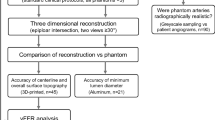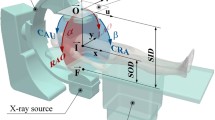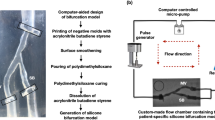Abstract
Purpose
Three-dimensional reconstruction of a vessel centerline from paired planar coronary angiographic images is critical to reconstruct the complex three-dimensional structure of the coronary artery lumen and the relative positioning of implanted devices. In this study, a new vessel centerline reconstruction method that can utilize non-isocentric and non-orthogonal pairs of angiographic images was developed and tested.
Methods
Our new method was developed in in vitro phantom models of bifurcated coronary artery with and without stent, and then tested in in vivo swine models (twelve coronary arteries). This method was also validated using data from six patients.
Results
Our new method demonstrated high accuracy (root mean square error = 0.27 mm or 0.76 pixel), and high reproducibility across a broad imaging angle (20°–130°) and between different cardiac cycles in vitro and in vivo. Use of this method demonstrated that the vessel centerline in the stented segment did not deform significantly over a cardiac cycle in vivo. In addition, the total movement of the isocenter in each image could be accurately estimated in vitro and in vivo. The performance of this new method for patient data was similar to that for in vitro phantom models and in vivo animal models.
Conclusions
We developed a vessel centerline reconstruction method for non-isocentric and non-orthogonal angiographic images. It demonstrated high accuracy and good reproducibility in vitro, in vivo, and in clinical setting, suggesting that our new method is clinically applicable despite the small sample size of clinical data.








Similar content being viewed by others
References
Brown BG, Bolson E, Frimer M, Dodge HT (1977) Quantitative coronary arteriography: estimation of dimensions, hemodynamic resistance, and atheroma mass of coronary artery lesions using the arteriogram and digital computation. Circulation 55(2):329–337. https://doi.org/10.1161/01.cir.55.2.329
Thompson CA (2014) Textbook of cardiovascular intervention, 1 edn. Springer, New York
Dowe DA, Fioranelli M, Pavone P (2013) Imaging croronary arteries, 2nd edn. Springer, New York
Chen SY, Carroll JD, Messenger JC (2002) Quantitative analysis of reconstructed 3-D coronary arterial tree and intracoronary devices. IEEE Trans Med Imaging 21(7):724–749
Dvir D, Marom H, Guetta V, Guetta V, Kornowski R, Kornowski R (2005) Three-dimensional coronary reconstruction from routine single-plane coronary angiograms: in vivo quantitative validation. Int J Cardiovasc Intervent 7:141–145
Cardenes R, Novikov A, Gunn J, Hose R, Frangi AF (2012) 3D reconstruction of coronary arteries from rotational X-ray angiography. In: 9th IEEE International Symposium on Biomedical Imaging (ISBI), 2–5 May 2012. pp 618–621. https://doi.org/10.1109/isbi.2012.6235624
Yang J, Wang Y, Liu Y, Tang S, Chen W (2009) Novel approach for 3-D reconstruction of coronary arteries from two uncalibrated angiographic images. IEEE Trans Image Process 18(7):1563–1572. https://doi.org/10.1109/TIP.2009.2017363
Sarwal A, Dhawan AP (2001) Three dimensional reconstruction of coronary arteries from two views. Comput Methods Programs Biomed 65(1):25–43. https://doi.org/10.1016/s0169-2607(00)00116-4
Ramcharitar S, Daeman J, Patterson M, van Guens RJ, Boersma E, Serruys PW, van der Giessen WJ (2008) First direct in vivo comparison of two commercially available three-dimensional quantitative coronary angiography systems. Catheter Cardiovasc Interv 71(1):44–50. https://doi.org/10.1002/ccd.21418
Saito T, Misaki M, Shirato K, Takishima T (1990) Three-dimensional quantitative coronary angiography. Biomed Eng IEEE Trans 37(8):768–777. https://doi.org/10.1109/10.102792
Tu S, Holm NR, Koning G, Huang Z, Reiber JH (2011) Fusion of 3D QCA and IVUS/OCT. Int J Cardiovasc Imaging 27(2):197–207. https://doi.org/10.1007/s10554-011-9809-2
Bourantas CV, Papafaklis MI, Athanasiou L, Kalatzis FG, Naka KK, Siogkas PK, Takahashi S, Saito S, Fotiadis DI, Feldman CL, Stone PH, Michalis LK (2013) A new methodology for accurate 3-dimensional coronary artery reconstruction using routine intravascular ultrasound and angiographic data: implications for widespread assessment of endothelial shear stress in humans. EuroIntervention 9(5):582–593. https://doi.org/10.4244/Eijv9i5a94
Tu SX, Xu L, Ligthart J, Xu B, Witberg K, Sun ZW, Koning G, Reiber JHC, Regar E (2012) In vivo comparison of arterial lumen dimensions assessed by co-registered three-dimensional (3D) quantitative coronary angiography, intravascular ultrasound and optical coherence tomography. Int J Cardiovasc Imaging 28(6):1315–1327. https://doi.org/10.1007/s10554-012-0016-6
Athanasiou LS, Bourantas CV, Siogkas PK, Sakellarios AI, Exarchos TP, Naka KK, Papafaklis MI, Michalis LK, Prati F, Fotiadis DI (2012) 3D reconstruction of coronary arteries using frequency domain optical coherence tomography images and biplane angiography. In: 34th Annual international conference of the IEEE Engineering-in-Medicine-and-Biology-Society (EMBS), San Diego, CA, Aug 28-Sep 01 2012. IEEE engineering in medicine and biology society conference proceedings. pp 2647–2650
Tu SX, Koning G, Jukema W, Reiber JHC (2010) Assessment of obstruction length and optimal viewing angle from biplane X-ray angiograms. Int J Cardiovasc Imaging 26(1):5–17. https://doi.org/10.1007/s10554-009-9509-3
Bourantas CV, Kourtis IC, Plissiti ME, Fotiadis DI, Katsouras CS, Papafaklis MI, Michalis LK (2005) A method for 3D reconstruction of coronary arteries using biplane angiography and intravascular ultrasound images. Comput Med Imaging Graph 29(8):597–606. https://doi.org/10.1016/j.compmedimag.2005.07.001
Martorell J, Santoma P, Molins JJ, Garcia-Granada AA, Bea JA, Edelman ER, Balcells M (2012) Engineered arterial models to correlate blood flow to tissue biological response. Ann N Y Acad Sci 1254:51–56. https://doi.org/10.1111/j.1749-6632.2012.06518.x
Faugeras O, Luong Q-T, Papadopoulo To (2001) The geometry of multiple images: the laws that govern the formation of multiple images of a scene and some of their applications. MIT Press, Cambridge
Moses DA, Axel L (2004) Quantification of the curvature and shape of the interventricular septum. Magn Reson Med 52(1):154–163. https://doi.org/10.1002/mrm.20105
Yang J, Cong W, Chen Y, Fan J, Liu Y, Wang Y (2014) External force back-projective composition and globally deformable optimization for 3-D coronary artery reconstruction. Phys Med Biol 59(4):975–1003
Lilly LS (2011) Pathophysiology of heart disease: a collaborative project of medical students and faculty, 5th edn. Wolters Kluwer/Lippincott Williams & Wilkins, Baltimore
Bourantas CV, Serruys PW, Nakatani S, Zhang Y-J, Farooq V, Diletti R, Ligthart JM, Sheehy A, van Geuns R-JM, McClean D, Chevalier B, Windecker S, Koolen JJ, Ormiston JA, Whitbourn R, Rapoza R, Veldhof S, Onuma Y, Garcia-Garcia HM (2014) Bioresorbable vascular scaffold treatment induces the formation of neointimal cap that seals the underlying plaque without compromising the luminal dimensions: a concept based on serial optical coherence tomography data. EuroIntervention. https://doi.org/10.4244/EIJY14M10_06
Acknowledgements
This work was supported in part by a grant from National Institutes of Health (R01 GM49039) and in part by Honjo International Scholarship.
Author information
Authors and Affiliations
Corresponding author
Ethics declarations
Conflict of interest
The authors declare no conflict of interest.
Electronic supplementary material
Below is the link to the electronic supplementary material.
Rights and permissions
About this article
Cite this article
Kunio, M., O’Brien, C.C., Lopes, A.C. et al. Vessel centerline reconstruction from non-isocentric and non-orthogonal paired monoplane angiographic images. Int J Cardiovasc Imaging 34, 673–682 (2018). https://doi.org/10.1007/s10554-017-1275-z
Received:
Accepted:
Published:
Issue Date:
DOI: https://doi.org/10.1007/s10554-017-1275-z




